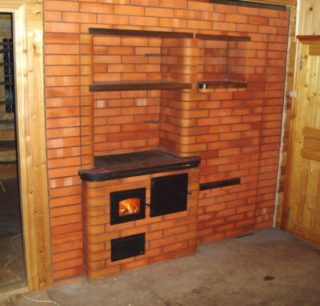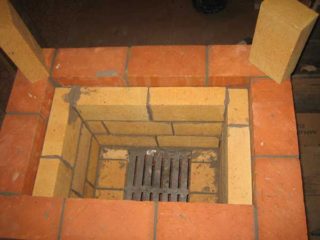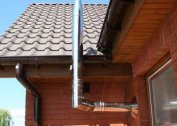Stove heating in a private house is a reliable and efficient option. But the furnace design must be chosen carefully. The device should warm the whole house, not just 1 room, and there are no additional sources of heat, like radiators or pipes. The Swedish stove heats the building and allows you to cook.
Swedish stove design
A rectangular brick structure designed for heating a house. Equipped with a hob, which is located in a niche, in the back of the case. An oven is also usually present.
In appearance, the Swede looks more like a Dutch woman than a Russian stove. The large area of the heating surface makes it effective. Typically, the unit is placed between the kitchen and the living room so that the hob and oven are in the kitchen space, and the flat heating surface is in the living room.
The scheme of the furnace is standard. Fuel burns in the firebox, hot gas is released, as well as heated air moves from the firebox through chimney channels, distributing heat. The main heat transfer is carried out in bell-shaped elements above the drying and furnace. The ratio of the elements of Sweden and additional designs - stoves, ovens, determines its features.
- The Swedish oven is located almost on the same level as the firebox, has large dimensions and is made of cast iron. When the stove is ignited, the oven plays the role of a hood - it helps burn the fuel and contributes to better heat generation. If you open the oven, after 3-4 minutes the kitchen will warm up. Ovens are often used in this quality.
- The Swedish brick stove is equipped with an upper niche. She also plays the role of an air cap. Also, the niche serves as a kind of drying chamber. Here you can dry 2-3 sets of wet winter clothes with shoes in 3-4 hours.
- The bottom niche is 1 whole with a hob. They cook here. When heating is stopped, the niche plays the role of a thermos. The food is kept warm and fresh until the next day. So that the mouse does not encroach on food, the niche is closed with a wooden lid.
- Chimney channels and the furnace are connected without high - this element increases the cost and complicates the design. But because of this, the Swede quickly cools down after the cessation of heating. To retain heat, immediately after the end of the furnace, you need to close the view.
To the rear of the stove, if it is located in a living room, shelves or a stove bench can be attached. The shelves are small - not more than 0.7 m wide, so lying on it is uncomfortable. Use it in another way: set a bed over the shelf. It is heated by warm air from a brick ledge, so you can sleep even in an unheated house with all the amenities. Bedclothes are often stored on the shelf, since here he is not threatened with dampness.
In the original design, the lower niche has the shape of an arch. However, its masonry requires high qualifications. In modern Swedes, they give it a simple rectangular shape.
Advantages and disadvantages of the furnace
The Swedish oven has many advantages. However, they are an advantage only for a small private house, where they live all year round.
Pros:
- Compactness - the basic design without a bed takes about 1 square. m. of area and reaches a height of 2 m.
- High efficiency - a furnace unit of this size heats up to 30 square meters. m. provided that it is installed on the border of 2 rooms. Although the efficiency of even a simple coal boiler is higher.
- Functionality - the oven heats the house, in it you can cook and even bake bread.Clothes and shoes are dried in the upper niche. If a lounger is attached, you can sleep on the stove. It is allowed to arrange a fireplace on the side facing the living room.
- Simple masonry - installation does not require high qualifications. However, the ordering should be carried out very carefully and accurately according to the scheme.
- Any fuel - you can use coal, wood, pellets, peat. But the amount of heat generated by the stove depends on the type of fuel.
- Profitability - in order to maintain an optimal regime in the country, it is enough to heat the Swede twice a day.
- The unit provides quick warm-up - in 3-4 minutes.
- A heat exchanger is a combination of vertical channels. They lessen soot and dust and do not need frequent cleaning.
The disadvantages of the Swede are also due to its design:
- The height of the fuel chamber is small. In addition, its upper part is a cast iron stove, which gives off heat much faster than a brick wall. Heat loss leads to severe cooling of the combustion zone. Fuel burns worse, not completely, so more coal or firewood is required to produce a certain amount of heat.
- The firebox door and hob are weak elements. The door is only allowed to be cast iron, as the stamped sheet quickly burns out. For the same reason, the hob has to be changed frequently.
- Masonry is performed only on fireclay clay, brick - red clay and fireclay.
- After a long period of inactivity, the Swede is melted in several runs, since the brick walls absorb a lot of moisture. For a summer residence, where in winter they live on short visits, this option is not suitable. It takes too long to prepare the stove for constant heating.
The Swedish oven can be turned into a real decoration. For facing, tiles, ceramics, decorative stone are used, provided that its thermal conductivity indicators coincide with the parameters of the brick.
Materials and Tools
For a Swedish stove, you will need:
- red brick for the body and chimney, fireclay for the furnace;
- fireclay clay for masonry mortar;
- furnace doors, cast iron grate;
- trowel, mallet, pickaxe hammer;
- as a rule, a plumb line, rail-ordering and other devices for checking masonry;
- square and tape measure, marker, pencil;
- buckets and shovels.
Additional tools and materials, such as tiles for cladding, may be needed.
DIY stove laying
The construction of the Swedes begins with preparation. It is necessary to calculate its power, find the optimal location - between the rooms, as close as possible to the center of the room. It is better to build a furnace at the same time as the building itself. It weighs about 3 tons and lay a separate foundation for it.
It is allowed to install the stove in the finished building, but for this you will have to disassemble the floors, wall, roof. It’s easier to get a metal counterpart of the Swedes - Ryazank or another cooking and heating mobile model.
- A hole is dug under the foundation, with a depth of 0.8–1 m. The value is determined by the level of soil freezing. The foundation must lie below this depth.
- The scheme is usual: up to 15 cm of compacted sand, 20 cm of broken brick and stone, 10 cm of gravel or gravel and a layer of concrete of such a height that it rises 15 cm above the ground level. All layers must be compacted. Concrete is reinforced with reinforcing mesh: it is placed in the upper layers, not reaching the open surface by 10 cm. The dimensions of the foundation are 10–15 cm larger than the dimensions of the furnace.
- After the concrete has dried, the foundation is waterproofed with roofing material.
- It is recommended to insulate the bottom of the furnace. The swedish is designed in such a way that it creates a powerful, downward flow of heat. In order not to lose it, several layers of basalt cardboard are laid under the base of the furnace. A more expensive way is to lay out the lowest row of fireclay bricks.
- Do it yourself with a Swedish oven according to a specific pattern. You can find a ready-made description for a variety of sizes.
- 1st and 2nd row are always continuous. Brick - clay, stacked with offset and with strapping. This base provides structural strength.
- In the 3rd and 4th row, an ashpit and cleaning holes are formed. All of them are closed by doors. Their installation is the same: on twisted steel wire, which is fixed directly into the brickwork. From the 5th row according to the drawing, they begin to form a firebox. It is laid out with fireclay bricks, since clay does not withstand this temperature. At the same time mount the oven. It is fixed in the same way as doors - a steel wire between the stones is walled up.
- In the 6th – 9th row, they continue to build the firebox. At 6, they also lay a chimney channel. Fireclay bricks inside the furnace and clay outside are laid so that there is an air gap between them. This prevents deformation of the walls. Fasten the furnace door.
- In the 9th row, the bricks in the chimney channel are laid at an angle. They give the necessary form to the grinder. This ensures the discharge of gases into the chimney. At 10 they complete the installation of the firebox by installing a horizontal partition, and at 11 they fix the hob.
- From 12 to 18, a series of chimneys is constructed according to the drawing. Their surface should be as smooth as possible. The walls carefully level and smooth the solution. In the 17th and 18th row, metal corners and supports are placed to overlap the cooking chamber. An almost continuous row of bricks is laid out here.
- From 19 to 28, they build the upper drying niche and lay openings for cleaning chimneys with views, and in 27 - a regulating valve.
- At level 29, smoke channels are blocked, leaving only one main opening for the chimney. Close and drying chamber.
- In the 30th row, they expand, and in the 31st they return to their original dimensions. Then they build up in a straight brick pipe. Floor overlapping is recommended to be insulated to avoid overheating. In the attic, you can connect a brick chimney with a metal one.
The height and structure of the chimney depends on the location and design of the roof. If the pipe is equipped at a distance of 1.5 m from the ridge, its height should exceed the ridge by 0.5 m. If the ridge is from 1.5–3 m, the chimney should reach the highest point of the roof.
Varieties of designs
The Swedish oven can be supplemented with appliances or have a simpler design. The upper niche is often abandoned, because even in the country, the need to dry so many clothes is rare.
There are other modifications. For example, in the forums you can find the model proposed by Batsulin. The simplified design is effective due to the arrangement of a two-channel chimney. The design of the three-way Swede proposed by Buslaev is more complicated, but it increases the efficiency by almost 60%.
With a couch
You can attach a stove bench to the back flat part of the furnace. The full-fledged design is large - up to 2 m long and up to 1.8 m wide. Heating such an element requires more fuel, so this model has large dimensions.
If they do not want to lose compactness, they attach shelves. The width of the protrusion is small - up to 0.7 m, position it as low as possible. It is rather a bench for a seat than a bench.
With stove and oven
A Swedish oven with oven and hob is a classic. The design necessarily includes a niche for the hob and a recess for the oven. A closed niche retains heat better than an open hob.
The upper drying compartment can be omitted. However, a small depression in the form of a shelf will not be superfluous: the food left here does not cool for a long time.
With fireplace
Beautiful, but not practical option. A fireplace is more a decoration of a room than a heater. Its efficiency is much lower, since all the heat is transferred to the room through the relatively small size of the hearth.The fireplace takes air for burning firewood from the room, the room needs to be equipped with powerful supply ventilation or to keep the windows open constantly.
The fireplace occupies a certain area of the rear wall - reduces the heating surface. At the same time, the design of the chimney is greatly complicated. Combustion products from the open hearth are also discharged through a common chimney, this can be arranged only by carefully calculating the furnace structure's steam meters and providing strong traction.
Making a Swede with a fireplace with your own hands is much more difficult. A popular option is the Swedish Ryazankin, striking in its compactness. However, there is a design flaw - thin walls.
Furnace operation
The main feature of the Swede is the “slow-moving” traction. The unit is designed for slow combustion of fuel. With intense burning, the thin-walled body overheats, and this causes damage to the joints and rapid wear. It is impossible to heat a Swede with flammable materials like straw or light brushwood.
Other recommendations should be followed:
- After downtime, the stove must not be melted at full capacity. Perform at least 3-4 runs.
- The ash chamber is cleaned of ash and ash every day. They clean the grate and release the furnace from the remains of unburned fuel.
- Once a year, the chimney must be cleaned. This is best done in the fall before the start of the heating season.
- Once every 3-4 years they inspect the firebox, ash pan, fireplace, if any. If damaged bricks or joints are found, it is necessary to replace them or update the masonry mortar.
The undoubted advantage of furnace heating in comparison with water heating is its high efficiency. The Swedish is drowned with coal, firewood, pellets, which is much cheaper. With the small size of the cottages, the structure is enough for heating.










